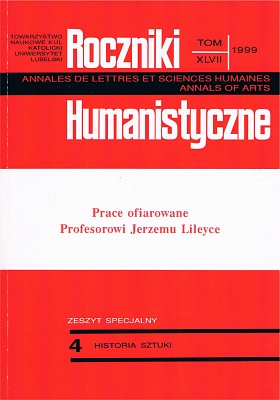Jacek Malczewski's The 1905 Revolution, Finis Poloniae or a Declaration of Love?
Abstract
Paintings by Jacek Malczewski (1854-1929), the most outstanding Polish symbolist painter often fell victim to “pathology of myth”, as Joseph Campbell defined the use of the spiritual sphere, which is myth, for political aims. In “pathology of myth” understood in this way almost all the modern painting can be placed, with propaganda-political contents, being at courts' service, apotheosising kings and leaders. In the case of Malczewski's works this was especially easy, as the artist extremely seldom gave titles to his paintings himself. It was done for him by his friends-critics. For his part the artist in letters (1876) and in an interview (1914) asserted that he painted his own feelings and his own life, adding that nobody understood his pictures. The work that is the subject of the article (Fig. 1) is a good example here. The painting was entitled The 1905 Revolution (1925), or Finis Poloniae (1977), interpreting it in the patriotic spirit. It was supposed to present an allegory of losing all hopes for Poland to regain independence (Poland was then depraved of its own sovereign state). The two women, between whom the artist is standing, were supposed to symbolise the invader states, Austria and Prussia. A. Ławniczakowa already sceptically assessed (1990) this interpretation, seeing in the women libido figures – the seducing power of the senses, antagonistic to the artist's spiritual vocation.
The suggestions to interpret the painting in a patriotic way were so strong that in my book published in 1996 I placed the picture in the chapter entitled “Homeland”. Now I have changed my opinion. Just at the time when the discussed picture was painted, Malczewski created a few of his best works. Their main protagonist was Maria Balowa – the artist's great love. The painting shows Malczewski standing against a vast landscape with the Muse and many-winged Pegasus between two women. In fact it is one woman – Maria Balowa, repeated twice. Snakes wreathe themselves around her naked breasts. These reptiles were the attribute of Asclepius – the patron of medical art, and they symbolised metamorphosis and healing. After all love not only changes a man, but also heals him. I consider this work by Malczewski to be The Apotheosis of the Artist and His Muse. Jacek Malczewski perfectly well knew art, especially Italian and Flemish of the 16th-18th centuries and he often drew inspiration from it. Here he used the composition formula known from paintings presenting apotheoses of rulers, in order to show affirmation of his personal love feelings. He used a similar composition in the portrait of his friend, Count Aleksander Wielopolski (Fig. 2) presented as Hercules at the cross-roads .
Copyright (c) 1999 Roczniki Humanistyczne

This work is licensed under a Creative Commons Attribution-NonCommercial-NoDerivatives 4.0 International License.





